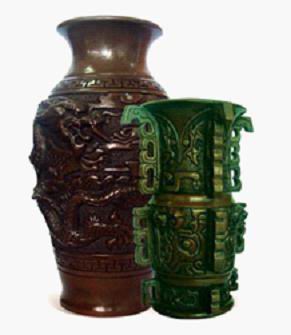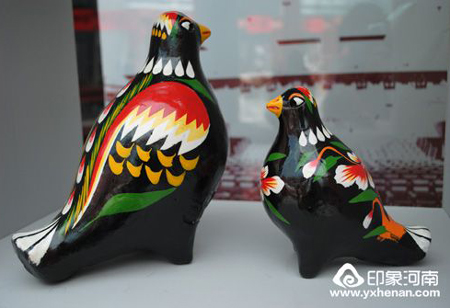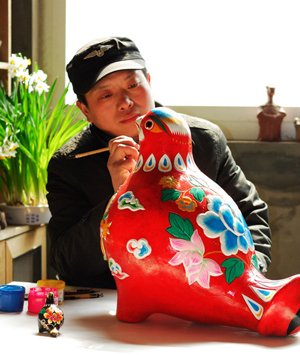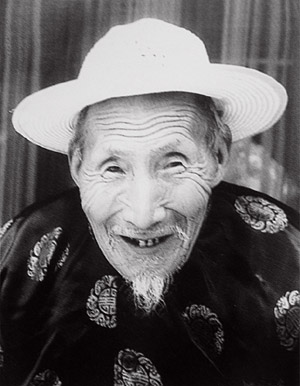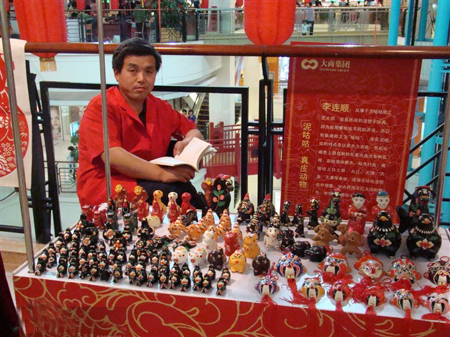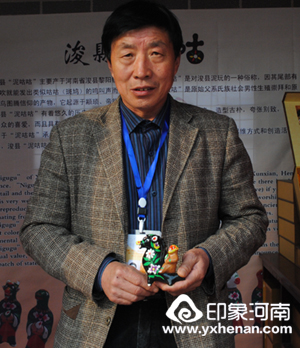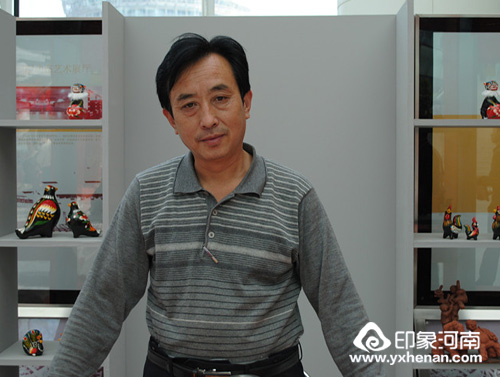精彩推薦
熱點關注
- 1、大湖九河黃酒釀造技藝
- 2、浚縣石雕
- 3、落腔
- 4、浚縣泥咕咕
- 5、河南非物質文化遺產(chǎn)——浚縣民間社火
- 6、浚縣正月古廟會
- 7、黃河古陶(浚縣)
- 8、大平調(浚縣)
專題推薦
-
沒有記錄!
熱點排行
- 1、大湖九河黃酒釀造技藝
- 2、浚縣石雕
- 3、落腔
- 4、浚縣泥咕咕
- 5、河南非物質文化遺產(chǎn)——浚縣民間社火
- 6、浚縣正月古廟會
- 7、黃河古陶(浚縣)
- 8、大平調(浚縣)
浚縣泥咕咕
2012/5/15 11:26:54 點擊數(shù): 【字體:大 中 小】
浚縣楊玘屯村是國家非物質文化遺產(chǎn)“呢沽沽”的集中產(chǎn)地,素有“泥玩具之鄉(xiāng)”、“泥塑第一村”之稱,被民俗學專家稱為研究歷史的活化石,是典型的地域文化,2006年,泥咕咕被國務院公布為首批非物質文化遺產(chǎn),被國家列入搶救保護項目。
浚縣泥塑藝術是以膠泥為原料,手工捏制人或動物的一種古老的民間藝術。“顏色以黑、赭石、白等為底色,藍、綠、白、黃、紅為花紋圖案顏色,顏色不經(jīng)調和,是用原色直接繪畫,很具有民俗鄉(xiāng)村韻味。”
浚縣泥塑主要集中在楊玘屯,據(jù)史料記載,在隋末農(nóng)民起義軍與隋軍的戰(zhàn)爭中,雙方為爭奪黎陽倉,有一員叫楊玘的大將在此屯兵,故后人將此村命名為楊玘屯村。當時,為了紀念在戰(zhàn)場上陣亡的戰(zhàn)友,將士們常捏制一些鴣鴣、戰(zhàn)馬、騎兵等以表懷念之情。現(xiàn)在,浚縣泥塑的創(chuàng)作題材有了很大拓展,又出現(xiàn)了獅子、小鳥、十二生肖等。其特點繼承并發(fā)展了古代雕塑的傳統(tǒng)工藝,顯得古樸、活潑、夸張而又豪放。
浚縣泥塑發(fā)展至今,已分化出各具特色的三大流派:以王藍田為代表的泥咕咕派;以“泥猴張”張希和為代表的泥猴派;以宋學海、宋慶春為代表的泥玩派。王派采用傳統(tǒng)手法捏制的泥咕咕可發(fā)出“咕咕”的聲音,其造型古樸、活潑,色彩斑斕。作品被收藏于英國倫敦大不列顛博物館,王藍田被聯(lián)合國教科文組織命名為民間工藝大師。王派傳人王學峰在繼承父輩傳統(tǒng)捏制的基礎上,不斷創(chuàng)新。2007年,王學峰被中國民間文藝家協(xié)會授予中國民間文化杰出傳承人,被文化部授予中國非物質文化遺產(chǎn)項目代表性傳承人。其作品“吉祥奧運”、“五福娃”、“獅子滾繡球”經(jīng)奧組委評審,參加了“揚帆奧運?中國民族民間藝術精品巡展”首展”;張派是以捏制泥猴而出名,故名為“泥猴張”,捏制的有雜技泥猴、頂缸泥猴、說唱猴、觀月猴、舞蹈猴、抽煙猴、醉酒猴等等,這些猴子造型奇特、虛構合理、變形得當、引人發(fā)笑。“泥猴張”被聯(lián)合國教科文組織授予“一級工藝美術家”稱號。以宋學海為代表的宋派捏制吹可發(fā)聲的泥人、泥馬、十二生肖等,被人稱為“泥人宋”。他曾被聯(lián)合國教科文組織和中國民間文藝家協(xié)會授予“民間工藝美術家”,被河南省文聯(lián)授予“民間工藝美術大師”稱號。作品先后被中央美術學院、中國美術博物館院等單位收藏。三大流派的作品在國際上產(chǎn)生了一定的影響。
浚縣政府對泥塑藝術的保護傳承、發(fā)展壯大非常重視,為此,引導其專門成立了“泥塑藝術研究會”,組建了楊玘屯泥塑藝術發(fā)展有限公司,實行公司+農(nóng)戶運作模式。楊紀屯泥塑藝術發(fā)展有限公司現(xiàn)有職工1000多人,中層管理人員30人,銷售人員50人,策劃人員10人,外地銷售網(wǎng)點5個,年產(chǎn)泥塑產(chǎn)品80余萬件,實現(xiàn)銷售收入600萬元。2007年,公司規(guī)劃建設了泥塑原生態(tài)村項目。該項目位于距國家4A景區(qū)——大伾山1公里的楊玘屯村。以大伾山景區(qū)為依托,報國家非物質文化遺產(chǎn)“泥咕咕”文化貫穿其中,形成集自然景觀、人文景觀、旅游休閑、動手參與等為一體的綠色時尚消費產(chǎn)業(yè)園。建設內容包括泥塑博物館、泥塑藝術培訓學校、生產(chǎn)車間、藝術燒制窯、生態(tài)園區(qū)等,總投資1470萬元。項目建成后,可發(fā)展泥塑作坊200個,帶動就業(yè)5000人,年實現(xiàn)銷售收入5000萬元,利稅300萬元。
Mud Goo Goo
Mud Goo Goo is a casual name for clay toys in Xunxian, which all have small shape changing from about 5 cm to less than 20 cm. There are two holes in the end and they can make GooGoo sounds when blew in the holes so that they are called Mud Goo Goo. Yangyi, Liyang County is the major producing area.According to the document Comprehensive Mirror to Aid in Government, at the end of Sui Dynasty, a general Yang Yi set troops there, whose name is used to name the village. At that time, there were some soldiers were able to made clay sculptures to remember died soldiers and horses in battlefield with local plaster. Later, some of them settled down there and handed down this making skill.
The basic component are figure, animal, bird and contains more than 100 kinds, mainly are figures from Work Romance of the Three Kingdoms and Water Margin and soldiers in Wagang, animals such as tiger, lion, turtledove, peacock and birds. A feature of Mud Goo Goo is that it chooses black as bottom color and paints all kinds of pictures on the bottom color. Colored drawing chooses black and brown as the bottom color and accompanied with pure pink, red, green and other colorful waves. All these color is toned with yolk to make sure the color will shimming and have a strong contrast. Mud Goo Goo has a graceful and plain appearance, and units with pure red and green color which makes it looks so beautiful. Generally, Mud Goo Goo has four making means: made with models, made by hand only, made with models and hand together, adding wire, spring, flexible lion head, etc, on clay toys. The materials and tools artists use are all very simple, usually got casually around them. Nowadays, it is mainly made in small manual workshops.
Mud Goo Goo has a very long history and tense folk characteristics. The products are all traditional, plain, exaggerated and unique, which is very popular with common people, experts and intelligences. It is praised as living fossil by folklore experts. Nowadays, the major inheritors are Wang Xuefeng, Wang Antian, Song Xuehai, etc. Pitifully, in current times, the young are unwilling to learn this craft skill any more. The traditional craft skill is lack of heritage and faces to being lost.
責任編輯:C006文章來源:印象河南網(wǎng)
下一條:落腔上一條:河南非物質文化遺產(chǎn)——浚縣民間社火
相關信息
精彩展示
沒有記錄!
評論區(qū)
